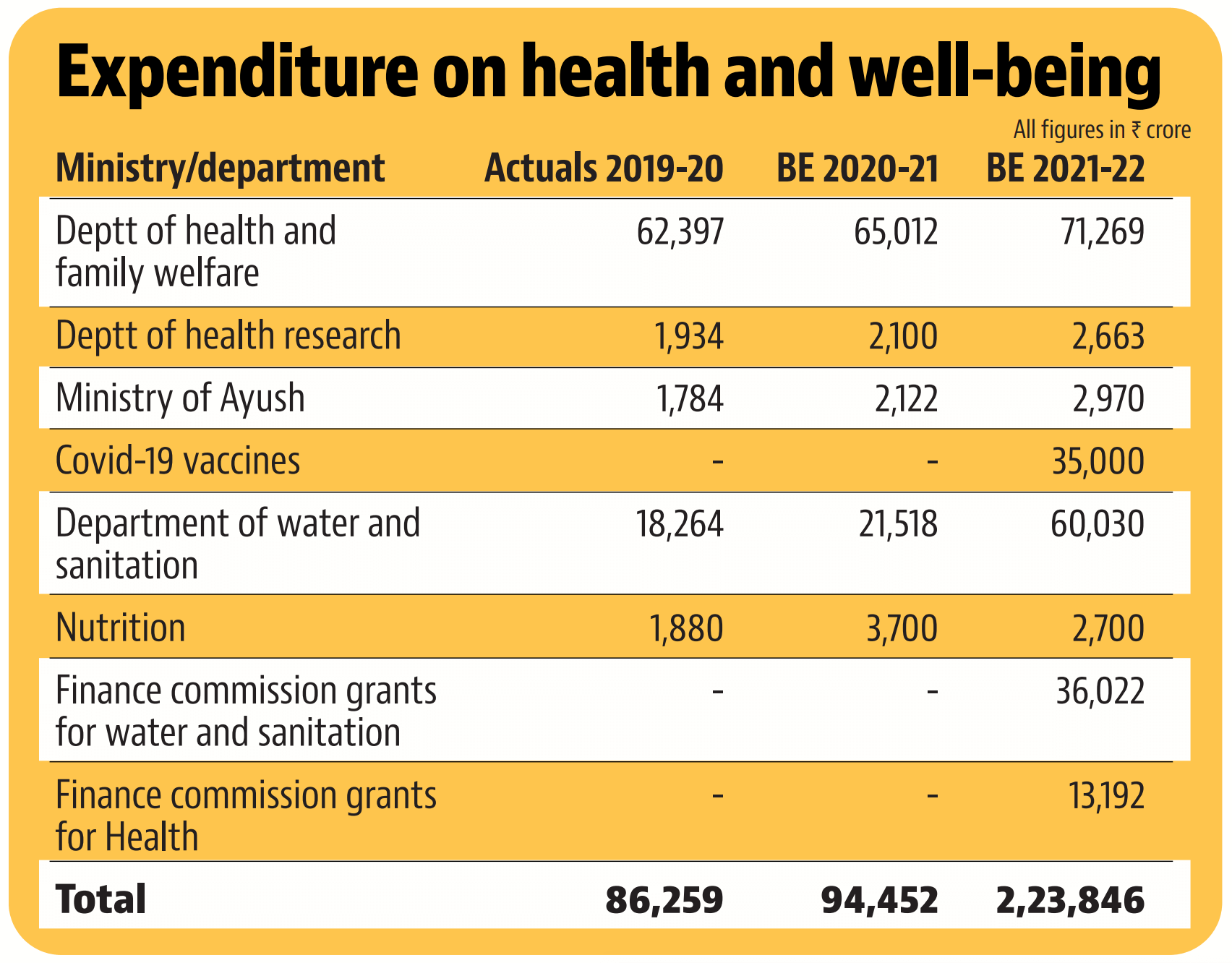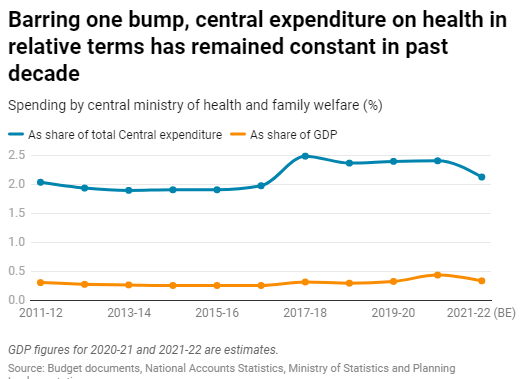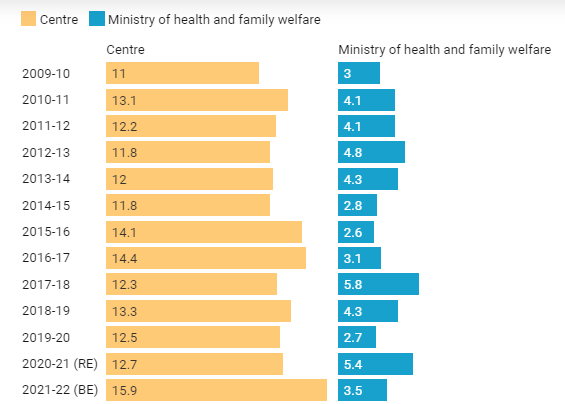HEALTHCARE BUDGET 2021: A THREADBARE ANALYSIS
1.jpg)
Introduction
India’s overall budgetary allocation for health and well being has soared by 137% in the financial year 2021-22 to Rs. 2.23 lakh crore compared to the budgeted spending in 2020-21 which was Rs 94,500 crore. The current spending of India remains 1.6% of the GDP. However, in the aftermath of the COVID-19 Pandemic the country seeks to boost the capacity of its health-care system to detect and cure new and emerging diseases.
Allocations in the current and next fiscal year

Features of the Health Budget
- The government is set to launch a new centrally sponsored initiative--PM Atmanirbhar Swasth Yojana with an outlay of Rs 64,180 crore over six years.
- The budgeted expenditure on the Ayushman Bharat health insurance scheme has been kept unchanged at Rs 6,400 crore.
- The increase in the healthcare budget is driven in large part by budgetary allocations for COVID vaccinations (Rs 35,000 crore, accounting for 27% of the increase) and an increase in water & sanitation costs (Rs 74,500 crore, accounting for 58% of the increase).
- The National Health Mission (NHM), a flagship healthcare scheme, has seen a mere 4% increase in allocations for the next fiscal.
- Rs 50,000 crore has been allocated for National Research Foundation.
- Another key vaccine – the pneumococcal vaccine, will be expanded to other states. Currently, the vaccine is being used only in five states.
- The government has proposed launching an improvised Mission Poshan 2.0 as malnutrition is one of the primary concerns in India because of which many health-related indicators are still not improving.
Significance of Higher Budget allocation
- The hike of 137 per cent in budgetary outlays towards the healthcare sector is a welcome move. The ministry of health and family welfare got just around 0.3% of gross domestic product (GDP) for much of the last decade.
- The funds under the Atmanirbhar Swasth Mission will be used to
- support 17,000 rural and 11,000 urban wellness centres,
- setting up integrated public health labs in all districts,
- over 3,800 block public health units in 11 States and
- establishing critical care hospital blocks in over 600 district hospitals and 12 central institutions
- Thus, Fund allocated under Atmanirbhar Swasth Yojana will help in developing capacities for primary, secondary and tertiary care health systems, strengthening existing institutions and creating new institutions for detection and cure of new emerging diseases.
- As the country continues to grapple with the pandemic, the outlay of Rs 35,000 crore towards vaccination will go a long way to stop the spread of COVID-19.
- Allocation for the National Research Foundation augurs well for R&D and innovation in the country.
- Expansion of Pneumococcal vaccine, that saves children from potentially fatal health conditions such as pneumonia, meningitis, and sepsis will avoid more than 50,000 child deaths annually in India.
- Mission Poshan 2.0 will strengthen nutritional content, delivery, outreach, and outcomes by merging the supplementary nutrition programme and the earlier Poshan Abhiyan.
- The health budget envisages strengthening the National Centre for Disease Control and its five regional units and 20 metropolitan health surveillance units. It will also expand national health information portal.

Concerns
- A closer look reveals that the 137 % hike in the health budget is the result of clubbing the allocations for the Ministry of AYUSH, drinking water and sanitation and nutrition all under the head of ‘health’.
|
The health budget includes the ‘Jal Jeevan Mission’ (urban), to achieve universal water supply in 4,378 urban local bodies with 2.86 crore household tap connections.
This is set to be implemented over five years, with an allocation of Rs 2.87 lakh crore. The health budget also took air pollution and waste management into its ambit. The launch of an “Urban Swachh Bharat Mission 2.0” for urban areas and focusing on waste management in cities was announced. For this, the government has set aside Rs 1.41 lakh crore to be spent over five years.
Finally, the Health budget also took air pollution and waste management into its ambit.
Thus, clubbing of different missions under the “Health” head might lead to insufficiency of funds.
|

- The budget has cut allocation by 27% – i.e. from last year’s allocation of Rs 3,700 crore for nutrition to this year’s Rs 2,700 crore.
- In addition, the government has announced that it intends to merge various nutrition programmes under a ‘Mission Poshan 2.0’, with a limited budget.
- Public health experts believe that the funds allocated towards covid-19 vaccination may fall short in achieving the target of vaccinating people against coronavirus. It might be insufficient to ensure free, universal and timely vaccination given that it would cost Rs 52,000 crores.
- Allocations for Central Sector and Centrally Sponsored Family Welfare schemes, which includes the budgets for procurement and distribution of contraceptives to states, is reduced by 35% (from Rs. 600 crores in FY 2020-21 to Rs. 387.15 crores in FY 2021-22). This is concerning since to maintain the momentum of India’s commendable performance in moving towards population stabilisation, investments in this area are critical.
- The National Urban Health Mission received only a Rs. 50 crore increase over the previous budget, from Rs. 950 crores to Rs. 1,000 crores.
- Due to clubbing of schemes and missions, the total allocation towards the healthcare sector has come down vis-a-vis RE for the financial year 2021. This could translate into cutting of expenditure on other avenues within the sector.
- The share of capital expenditure in overall central health spend is abysmally low. Nearly the entire budget goes on revenue expenditure, to meet running expenses such as salaries, maintenance and administration costs.


A CASE IN POINT
National Health Mission, envisages achieving universal access to healthcare. According to the Economic Survey, the NHM has been crucial in enabling access to institutional births and pre- and postnatal care.
Yet, the expenditure on NHM grew around 11% a year on average in the five years before the pandemic, as compared to 13% for overall health spending. Revised estimates for 2020-21, the pandemic year, show a mere 1.1% increase.
|
- The health ministry’s allocation as a share of total spending in the next fiscal is set to be lower than even the pre-pandemic level of 2019-20. As a share of GDP, it will be nearly the same.
- The continuing modest allocation towards the healthcare sector would make it challenging for the Government to meet its target of public sector healthcare investment of 2.5% of the GDP by 2025.
Conclusion and Way Ahead
Increased focus on healthcare spending - a long-pending demand of the healthcare industry - is a big positive for the healthcare industry. The proposed initiatives, such as setting up health and wellness centres and integrated public health labs in each district, will support in further widening access to healthcare services in the remotest corners of the country whilst also navigating the focus on preventive health. However, we must not lose our focus on maternal, child and adolescent health, including family planning.
Prioritising social sector spending on women and young people’s health is central to all our futures. It will spur economic growth and recovery by ensuring a healthy population and ensure that the current health crisis does not increase existing gender disparities in access to affordable and quality healthcare.
A closer examination of budgetary allocations to healthcare shows that not all segments have gained equally. Investments in health infrastructure and greater support to flagship schemes such as the NHM are essential to ensuring better health outcomes for Indians in the years to come.
Also, the pandemic has underscored the need for investment into adequate and robust healthcare infrastructure. There is a need to prioritize greater capital expenditure to enable India’s long-term health infrastructure. Capital expenditure is crucial for the creation of new hospitals and other such infrastructure. The PMANSBY is, therefore, a step in the right direction.





1.jpg)
